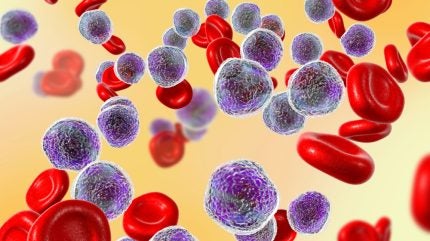
At the 2025 Congress of the European Hematology Association (EHA 2025), held from 12 June 12 to 15 June in Milan, Italy, preliminary dose-escalation and optimisation results from the global, multicentre, open-label, single-arm Phase I/II SYRUS clinical trial (NCT06137118) were presented on the second day. This trial evaluated the safety, tolerability, pharmacodynamics, pharmacokinetics and clinical activity of AstraZeneca’s surovatamig, a next-generation CD19xCD3 bispecific T-cell engager (BiTE), in treating patients aged 12 and over with relapsed/refractory (R/R) B-cell acute lymphoblastic leukaemia (B-ALL) as a monotherapy.
ALL is an aggressive haematologic malignancy characterised by the overproduction of immature lymphoid cells (lymphoblasts) in the bone marrow, blood and other organs, and it most commonly arises from B-cell precursors. B-ALL accounts for between 7% and 85% of total ALL cases. ALL is most often diagnosed in young children and adolescents but can occur at any age, with incidence again increasing in older adults.
According to GlobalData’s Acute Lymphocytic Leukemia: Epidemiology Forecast to 2029 report, the number of diagnosed incident cases in the eight major markets (8MM: China, France, Germany, Italy, Japan, Spain, the UK and the US) is projected to increase from 25,636 in 2025 to 26,482 by 2029 at an annual growth rate of 1.16%. Similarly, the number of diagnosed five-year prevalent cases of ALL in the 8MM is projected to increase from 92,038 in 2025 to 95,443 by 2029.
In the SYRUS trial, 120 patients with relapsed or refractory B-cell acute lymphoblastic leukaemia (R/R B-ALL) were enrolled across three arms: dose escalation, dose optimisation and expansion. In the dose-escalation arm, patients with CD19-positive Philadelphia chromosome-positive or negative (Ph+ or Ph-) B-ALL who had failed at least one or two previous therapies received intravenous surovatamig. At dose level 1, cytokine release syndrome occurred in 31% (4 of 13) during the step-up dosing phase and in 30% (3 of 10) during the target dose phase; no grade 4 events were observed in either case.
A low incidence of immune effector cell-associated neurotoxicity syndrome was reported during the step-up dosing phase and the target dose phase. Two patients experienced dose-limiting toxicities and continued to receive the targeted dose. The complete remission or complete remission with incomplete recovery rates were 46% (6 of 13), 58% (7 of 12) and 83% (5 of 6) at dose levels 1, 2, and 3 respectively. Overall response rates were 67% in dose level 1 and 100% at dose level 2. Patients previously exposed to CD19-targeted therapy also demonstrated promising efficacy. No patients discontinued treatment due to surovatamig-related adverse events and no new safety signals were identified. These primary results suggest that surovatamig, at doses up to 15mg, is active and well-tolerated in patients with R/R B-ALL.
The US Food and Drug Administration (FDA) approved Amgen’s Blincyto (blinatumomab), the first bispecific T-cell engager (BiTE), in 2014 for adults with Ph- R/R B-ALL, with its label expanded in 2017 to include Ph+ and paediatric cases. Despite advances with BiTEs such as Blincyto, antibody-drug conjugates such as Pfizer’s Besponsa (inotuzumab ozogamicin) and chimeric antigen receptor T-cell (CAR-T) therapies such as Autolus Therapeutics’ Aucatzyl (obecabtagene autoleucel), R/R B-ALL remains an area of high unmet need due to limited durability of response, CD19 relapse and lack of accessible curative options beyond stem cell transplant.

US Tariffs are shifting - will you react or anticipate?
Don’t let policy changes catch you off guard. Stay proactive with real-time data and expert analysis.
By GlobalDataSurovatamig is Fc-engineered [using the modification of the crystallisable fragment (Fc) region of an antibody to enhance its therapeutic properties] for extended half-life and optimised CD3 binding, enabling intermittent dosing and controlled T-cell activation. This design offers a more convenient and potentially safer alternative to Blincyto’s continuous infusion. Beyond R/R B-ALL, surovatamig is in Phase III trials as monotherapy for diffuse large B-cell lymphoma and in combination with Biogen’s Rituxan (rituximab) for untreated follicular lymphoma.
While surovatamig shows promise, it needs to outperform established therapies such as Blincyto and Aucatzyl. According to GlobalData’s analyst consensus forecast, surovatamig’s global sales are projected to reach $138 million by 2031, compared to $1.7 billion for Blincyto. However, Blincyto’s loss of exclusivity in Europe (2025) and the US (2026) is expected to significantly reduce its future sales.





